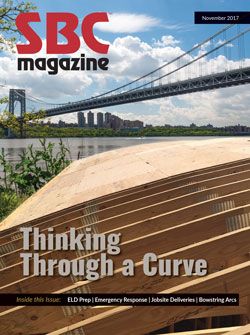Faces of the Industry: Becki Kyle
Faces of the Industry: Becki Kyle
How did you get into this industry?
 I started at 19. Lowe’s opened, and they were paying six bucks an hour, which was a dollar more than I was getting paid. So I started out at Lowe’s at the millwork counter, helping people with windows and doors and deck projects. I was headhunted by a guy from Wicks Lumber (who subsequently ended up being my father in law!) so I went over there and was an outside sales coordinator for six years. I was working my way through school – I was a die-hard biology major, I love biology! – and I quit work just to finish up my last semester so I could take as many class hours as I needed to. I graduated, and after that, I needed to get a job.
I started at 19. Lowe’s opened, and they were paying six bucks an hour, which was a dollar more than I was getting paid. So I started out at Lowe’s at the millwork counter, helping people with windows and doors and deck projects. I was headhunted by a guy from Wicks Lumber (who subsequently ended up being my father in law!) so I went over there and was an outside sales coordinator for six years. I was working my way through school – I was a die-hard biology major, I love biology! – and I quit work just to finish up my last semester so I could take as many class hours as I needed to. I graduated, and after that, I needed to get a job.
In the summer of 2004 I was looking to start a career in my field of study, but meanwhile I went to Big C Lumber to see if they needed any help. I ended up working at the inside sales counter. The longer I was there, the more responsibilities I started accepting! And the more responsibilities I had, the fewer resumes I was sending out. Then there was an opening in the drafting department in 2007, so I applied and started doing drafting.
A couple months later, [Design Manager] Dallas Austin started training me in EWP design and from there I fell in love! This is kind of like biology – a building is like an organism with all the different parts working together. It just intrigued me, the whole-house aspect. What goes into it from the foundation to the roof peak. So it wrote its own story from there. I’ve been with Big C for 13 years, doing whole-house designs. My knowledge from when I started out at 19 to now – it’s been quite the evolution.
An evolution – that’s interesting. What’s changed since you started your career?
Our sales area is becoming more and more custom-built homes. When I started out, the majority was cookie-cutter homes. Custom homes take a lot more time to design.
The biggest struggle right now is the quality of the prints that come in, especially on the custom homes. It’s very difficult, when they’re poor quality or incomplete. It makes the job stressful because you are not just designing once – it’s taking two or three redesigns to get something right. Even then, the crews out on the jobsite are sometimes changing things on the fly, and that doesn’t work well, especially when it’s a complex house. When they change one thing, it can affect other things. (Maybe this is due to HGTV inspiring homeowners!)
I just wish people would realize the importance of a good blue print. It tells a story; it’s supposed to tell a good one. There’s been so much turnover, I think there’s still a learning curve in several aspects of the industry from the recession, even though it’s been a while. I think a lot of people don’t want to pay the price for a completed print as well. They don’t realize it saves them money in the long run not having to work out the errors that come from not having a good print.
There’s also been an increase in the use of engineered floor systems over dimensional floors. We’re getting a few more floor truss projects coming in, but the majority of the floor systems that we have go through Big C are I-joists. The way sales of I-joists have been increasing, I’d say they’re the preferred system over dimensional framing. But floor trusses still haven’t really taken hold in our market. The majority of the builds in this area have basements, and some builders want that clean look that floor trusses can offer with running chases in them. It’s gaining ground, but it’s just not taking off like I-joists did. It’s a little more expensive – if you do an I-joist/floor truss comparison, the I-joists win out if you’re not willing to change your on center spacing – but it’s more a preference thing. If you want to hide your mechanicals or you want a long clear span (homeowners aren’t even wanting beams and posts these days!), then you go with floor trusses.
Finally, I think constant collaboration between floor and roof truss designers is necessary now, with the custom houses being built today. It is beneficial for a builder to get their floor and roof through one supplier to ensure the whole house will be sound structurally, all load transfers accounted for. We have an awesome team of designers here at Big C, who strive to bring our motto, "Begin with Strength, End with Beauty," to every design.
What do you like best about your work in this industry?
Being challenged. You continue to learn how to do something better. I like to not get into such a mundane routine. I think that’s why Dallas throws me some floor and roof trusses to design. Having different aspects of a project to work on keeps you fresh.
And I enjoy the banter with my coworkers here. We have some good stories.
What’s Big C focused on right now?
Big C, as a whole company, is focusing right now on getting into social media: getting more active on Facebook and LinkedIn.
In the component plant, we’re getting more involved in hosting events here to help building code officials and framers understand exactly what we do, so they have an idea of our procedures and the industry standards. We are also working on reducing our paper usage. We are about 90% paperless out in production, and we’re experimenting with large monitors for the designers to show prints in lieu of actually having a hard copy.
What challenges is the industry facing?
I think the challenge is getting people to come work in this industry. It’s not something that’s really on anybody’s radar – you just stumble into it or know somebody that’s in the industry and get involved that way. I know schools are implementing PLTW (Project Lead The Way) and STEM (science, technology, engineering and mathematics) programs, but I’m not sure how much our industry really gets brought up in classes like that.
Also, it’s hard to find the person who will start out in this industry and deal with the stresses and frustrations that we have. You really have to push yourself to design on short notice and be accurate. A younger person, they’re just like, “why?”
Going into colleges that are more technically focused is a good start. We hired two individuals from a construction management program and they have been working out very well. My husband, actually, was a PTLW teacher, and he actually trained on truss design in regard to loading. I think if we could hit some of the high-school-level kids or visit the magnet schools that focus on engineering, that would be a good way to get the word out about our industry.
When you’re not thinking about EWP design and trusses, what keeps you busy?
House maintenance. We’ve been doing a lot of house painting.
Hobby-wise, we’re pretty avid back-country hikers. We like the Rockies, but we’ve done the Smokies quite a few times, hit the Appalachian Trail, just sectioning, but the Rockies is probably our favorite. We did our first fourteener – a mountain over 14 thousand feet in elevation – so that was pretty spectacular. And we go jeeping, mudding. It is amazing what trails you can go on in a jeep!

